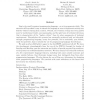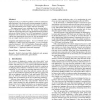1264 search results - page 147 / 253 » Abstract machines for programming language implementation |
IPPS
2010
IEEE
13 years 6 months ago
2010
IEEE
It is possible to implement the parallel random access machine (PRAM) on a chip multiprocessor (CMP) efficiently with an emulated shared memory (ESM) architecture to gain easy par...
HOPL
1993
14 years 9 days ago
1993
Lisp is the world’s greatest programming language—or so its proponents think. The structure of Lisp makes it easy to extend the language or even to implement entirely new dial...
PEPM
2010
ACM
14 years 5 months ago
2010
ACM
Duplicated code is a well known problem in software maintenance and refactoring. Code clones tend to increase program size and several studies have shown that duplicated code make...
AOSD
2005
ACM
14 years 1 months ago
2005
ACM
Improving the structure of code can help developers work with a software system more efficiently and more consistently. To aid developers in re-structuring the implementation of c...
ESOP
1998
Springer
14 years 13 days ago
1998
Springer
Abstract. In the eld of reactive system programming, data ow synchronous languages like Lustre BCH+85,CHPP87 or Signal GBBG85 o er a syntax similar to block-diagrams, and can be e ...


